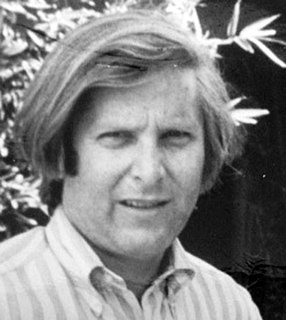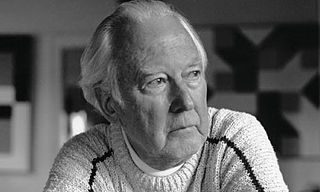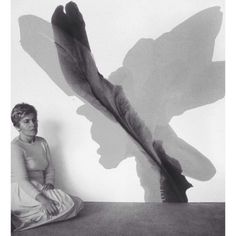Related Research Articles
Abstract expressionism is a post–World War II art movement in American painting, developed in New York City in the 1940s. It was the first specifically American movement to achieve international influence and put New York at the center of the Western art world, a role formerly filled by Paris.

Hard-edge painting is painting in which abrupt transitions are found between color areas. Color areas are often of one unvarying color. The Hard-edge painting style is related to Geometric abstraction, Op Art, Post-painterly Abstraction, and Color Field painting.

Color field painting is a style of abstract painting that emerged in New York City during the 1940s and 1950s. It was inspired by European modernism and closely related to abstract expressionism, while many of its notable early proponents were among the pioneering abstract expressionists. Color field is characterized primarily by large fields of flat, solid color spread across or stained into the canvas creating areas of unbroken surface and a flat picture plane. The movement places less emphasis on gesture, brushstrokes and action in favor of an overall consistency of form and process. In color field painting "color is freed from objective context and becomes the subject in itself."

Joseph Raffael was an American contemporary realist painter. His paintings, primarily watercolors, are almost all presented on a very large scale.
James Edward Grant was an American painter and sculptor active from the late 1950s into the early 1970s. Best known for his sculptural work in plastics, this work by no means defined him, but was rather a natural endpoint of an exploration into increased dimensionality—starting from abstract canvases, moving through collages and bas-reliefs until the work finally came off the wall in sculptural form.
Peter Young is an American painter. He is primarily known for his abstract paintings that have been widely exhibited in the United States and in Europe since the 1960s. His work is associated with Minimal Art, Post-minimalism, and Lyrical Abstraction. Young has participated in more than a hundred group exhibitions and he has had more than forty solo exhibitions in important contemporary art galleries throughout his career. He currently lives in Bisbee, Arizona.

John Levee was an American abstract expressionist painter who had worked in Paris since 1949. His father was M. C. Levee.
Maxwell Hendler is an American painter. In 1975, he became the first contemporary artist to have pictures in the collection of the Metropolitan Museum of Art in New York.

Frederick Hammersley was an American abstract painter. His participation in the 1959 Four Abstract Classicists exhibit secured his place in art history.

Peter Plagens is an American artist, art critic, and novelist based in New York City. He is most widely known for his longstanding contributions to Artforum and Newsweek, and for what critics have called a remarkably consistent, five-decade-long body of abstract formalist painting. Plagens has written three books on art, Bruce Nauman: The True Artist (2014), Moonlight Blues: An Artist's Art Criticism (1986) and Sunshine Muse: Modern Art on the West Coast, 1945-70 (1974), and two novels, The Art Critic (2008) and Time for Robo (1999). He has been awarded major fellowships for both his painting and his writing. Plagens's work has been featured in surveys at the Museum of Modern Art, Los Angeles County Museum of Art (LACMA), Whitney Museum, and PS1, and in solo exhibitions at the Hirshhorn Museum and Las Vegas Art Museum. In 2004, the USC Fisher Gallery organized and held a 30-year traveling retrospective of his work. Critics have contrasted the purely visual dialogue his art creates—often generating more questions than answers—with the directness of his writing; they also contend that the visibility of his bylines as a critic has sometimes overshadowed his artmaking—unduly. Los Angeles Times critic David Pagel described Plagens's painting as a "fusion of high-flying refinement and everyday awkwardness" with an intellectual savvy, disdain for snobbery and ungainliness he likened to Willem de Kooning's work. Reviewing Plagens's 2018 exhibition, New York Times critic Roberta Smith called the show an "eye-teasing sandwich of contrasting formalist strategies," the hard-won result of a decade of focused experimentation.

Charles Christopher Hill is an American artist and printmaker. Hill lives and works in Los Angeles, California and was married to the late Victoria Blyth Hill, an art conservator. He has been artist in residence at Cité International Des Arts, Paris, France, at Chateau de La Napoule, La Napoule, France and at Eklisia, Gümüslük, Turkey (1994).
James Hayward is a contemporary abstract painter who lives and works in Moorpark, California. Hayward's paintings are usually divided in two bodies of work: flat paintings (1975-1984) and thick paintings. He works in series, some of which are ongoing, and include The Annunciations, The Stations of the Cross, the Red Maps, Fire Paintings, Smoke Paintings, Sacred and Profane and Nothing's Perfect series.
Tom Holland is an American visual artist. Holland is known for creating a style of art that may use fiberglass, aluminum, epoxy paint, plywood, beads, oil paint, palette knives, marble, copper, paper, and clay. For clay he uses watercolor, acrylic urethane, and ceramic glazes.
Edith Baumann is an abstract artist based in Santa Monica, California. Her paintings are minimalist and include geometric repetition and patterns, often presented in intense colors.
Mary Corse is an American artist who lives and works in Topanga, California. Fascinated with perceptual phenomena and the idea that light itself can serve as both subject and material in art, Corse's practice can be seen as existing at an crossroads between American Abstract Expressionism and American Minimalism. She is often associated with the male-dominated Light and Space art movement of the 1960s, although her role has only been fully recognized in recent years. She is best known for her experimentation with radiant surfaces in minimalist painting, incorporating materials that reflect light such as glass microspheres. Corse initially attended University of California, Santa Barbara starting in 1963. She later moved on to study at Chouinard Art Institute, earning her B.F.A. in 1968.
Merion Estes is a Los Angeles-based painter. She earned a B.F.A. at the University of New Mexico, in Albuquerque, and an M.F.A. at the University of Colorado, in Boulder. Estes was raised in San Diego from the age of four. She moved to Los Angeles in 1972 and first showed her work at the Woman's Building in Los Angeles. As a founding member of Grandview 1 & 2, she was involved in the beginnings of Los Angeles feminist art organizations including Womanspace, and the feminist arts group "Double X," along with artists Judy Chicago, Nancy Buchanan, Faith Wilding, and Nancy Youdelman. In 2014, Un-Natural, which was shown at the Los Angeles Municipal Art Gallery in Los Angeles and included Estes' work, was named one of the best shows in a non-profit institution in the United States by the International Association of Art Critics.

Hassel Smith was an American painter.

Ron Linden is a California abstract painter, independent curator, and associate professor of art at Los Angeles Harbor College, Wilmington. He lives and works in the San Pedro area of Los Angeles.

Irene Monat Stern (1932-2010) was a Polish-American artist who spent her working life in the United States. Known for her abstract paintings, her works have been displayed and collected across the United States; from The Esther-Robles Gallery in Los Angeles, to the Metropolitan Museum of Art in New York, to the Hirshhorn Museum and Sculpture Garden in Washington D.C.'s permanent collection.

Ethel Fisher was an American painter whose career spanned more than seven decades in New York City, Miami and Los Angeles. Her work ranges across abstraction and representational genres including large-scale portraiture, architectural "portraits," landscape and still-life, and is unified by a sustained formal emphasis on color and space. After studying at the Art Students League in the 1940s, Fisher found success as an abstract artist in Florida in the late 1950s, and began exhibiting her work nationally and in Havana, Cuba. Her formative work of this period embraced the history of art, architecture and anthropology; she referred to it as "abstract impressionist" to distinguish her approach to form and color from that of Abstract Expressionism.
References
- ↑ Tom Savage biography, Artnet
- ↑ From the documentary short film Tom Savage: Visual Poetics on YouTube, October 2008
- ↑ "Abstract Contradictions," by David Pagel, Los Angeles Times, March 30, 1995
- ↑ "Tom Savage at Cirrus," by Peter Kosenko, Artweek, Vol. 26, No. 5, May 1995
- ↑ "Image Makers: L.A. Artists Return to Abstraction," by David DiMichele, Los Angeles Downtown News, April 17, 1995
- ↑ "Contemplative," by David Pagel, Los Angeles Times, August 22, 1996
- ↑ Tom Savage, Paintings & Works on Paper (official site)